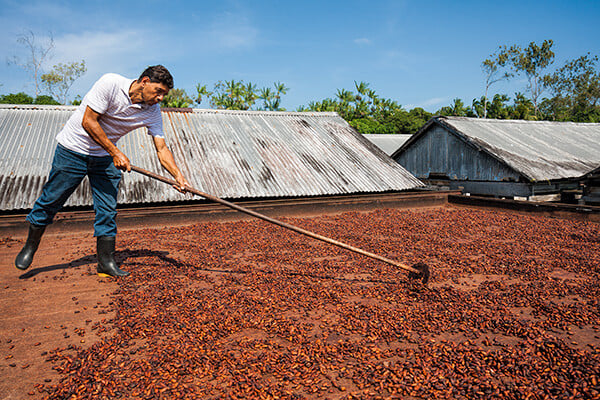
Chocolate is one of the world’s most beloved indulgences, and its production and consumption tell a fascinating story of cultural heritage, global trade, and culinary innovation.
Sweet Sensation
When was the last time you ate chocolate? Was there chocolate in your morning coffee drink or granola bar? Have you recently nibbled a chocolate chip cookie? Did you unwrap a square of bittersweet as your mid-afternoon pick-me-up or before-bed treat?
Chances are your last taste of chocolate was not that long ago. Vanilla may be the world’s favorite flavor, but the average American consumes around 11.5 pounds of chocolate per year.
More than 60% of all candy sold in the U.S. is chocolate. Of that, 50% is milk chocolate, with Hershey being the largest manufacturer. In the last decade or so, bittersweet chocolate, generally classified as “dark” chocolate, has made inroads as tastes change and public perception of being a healthy choice grows. But whatever your preference, around the world, chocolate is celebrated as something both ordinary and special, to drink and eat.
 Revisit this Boss Magazine article to learn more about Milton S. Hershey’s sweet story of success
Revisit this Boss Magazine article to learn more about Milton S. Hershey’s sweet story of success
Perhaps surprisingly, unlike sugar or other large-scale agricultural products, chocolate is a big business supported by many small ones. Theobroma cacao, the tree that produces the fruit whose seeds or beans produce what eventually will become chocolate, thrives only in certain subtropical areas that fall between 20 degrees north and south of the equator. Cacao farms are usually family-owned and quite small, approximately seven to 10 acres each, and are tended to and harvested by hand. Cacao is native to South America, and at the beginning of the last century, most of these farms were in Latin America. Today, among the roughly 60 countries that produce cacao beans, the majority are in Africa, with Côte d’Ivoire and Ghana leading production.
Cacao trees typically need two to three years of growth after planting to produce the flower clusters that, when pollinated, will become their fruit or pod. Pods that grow to be roughly the size of a football, in turn, are ready for harvest approximately six months after pollination. After harvesting the pods by hand, workers cut the fruit in two with a machete to release the beans, which are encased in a sticky white pulp. Removing the pulp from the beans requires a process known as fermentation, where the beans are laid out in trays and covered with banana leaves for anywhere from two to seven days. The fermentation process also produces the flavor and aroma that we associate with chocolate. After fermentation, the beans are laid out to dry outdoors for several days, and they are turned three to five times daily to maintain an even dryness.
 Spreading cocoa beans to dry on a wooden platform in Brazil; Photo courtesy iStock, renacal1
Spreading cocoa beans to dry on a wooden platform in Brazil; Photo courtesy iStock, renacal1
When the drying is complete, they are transferred to chocolate factories, where the beans are roasted and then winnowed to separate the hulls from the cacao nibs. The nibs are put through several rollers that grind them into a paste known as cacao mass or liquor. This is the starting point for both solid chocolate and cocoa powder, which is made from cacao beans that have been roasted when processed.
For solid chocolate, sugar, and cocoa butter plus an emulsifier like lecithin are added to transform the pasty chocolate liquor into a solid that will melt at mouth temperature. If the chocolate is to become milk chocolate, powdered or evaporated milk is added at this point, too. The chocolate mass is then rolled and conched, a process that takes place in a shell-shaped mixer that moves and aerates the chocolate until it is smooth. Inexpensive chocolate may be conched for four to 12 hours; premium chocolate for three to seven days. Finally, the chocolate is tempered, a process where chocolate is heated and cooled slowly so that the cocoa butter crystallization remains even, and the chocolate appears glossy and without whitish streaks or patches.
For Americans coming of age in the first half of the 20th century, chocolate was either milk or dark. Milk chocolate has less chocolate paste than dark chocolate, plus the inclusion of milk. Dark chocolate has a higher percentage of chocolate paste, as well as a lower amount of sugar. Today, we see gourmet dark chocolate boasting 60 to 70% chocolate, but in the U.S., 35% is the minimum required amount of chocolate paste to be labeled dark chocolate. In Europe, it is 43%.
White chocolate, on the other hand, contains no chocolate paste. It gets its name–and its creamy color–from cocoa butter, milk solids, sugar, and vanilla.
Many claims have been made for the health benefits of dark chocolate–that it lowers blood pressure, is a mood elevator, an antioxidant, and possibly an aphrodisiac. According to the Harvard T.H. Chan School of Public Health, cocoa does present a high percentage of flavanols, which can help reduce both blood pressure and increase insulin sensitivity, which could reduce the chance of diabetes. They also cite observational studies, which suggest that eating one to two small squares of dark chocolate each day may lead to a reduction in heart disease. As for a mood elevator, treat yourself to a piece of chocolate, or better yet, offer one to a friend. The results will be obvious.

Global Chocolate Industry
The love of chocolate isn’t limited to the U.S. In fact, when it comes to global chocolate consumption, Americans aren’t even in the top 5.
- Switzerland: 22-26 lbs. (10-12 kg) per person
- Germany: 20-24 lbs. (9-11 kg) per person
- Austria: 18-22 lbs. (8-10 kg) per person
- Ireland: 15-20 lbs. (7-9 kg) per person
- United Kingdom: 15-18 lbs. (7-8 kg) per person
These figures reflect a strong cultural appreciation for chocolate in Europe, where many of the world’s finest chocolatiers originate, including George Cadbury.
Although cocoa is mainly produced in Africa and Central and South America, most chocolate is manufactured in Europe and North America. Germany is the world’s leading exporter of chocolate, producing 16.9% of total chocolate exports. The top 5 chocolate exporting countries are:
- Germany: $6.3 billion
- Belgium: $4 billion
- Poland: $2.7 billion
- Italy: $2.66 billion
- Netherlands: $2.55 billion
Dixon Solutions for Chocolate Production
No matter the location or type, manufacturing chocolate requires high-quality products designed to maintain an ideal product temperature and optimize efficiency throughout the delicate process. Dixon is delighted to play a role in providing solutions for chocolate production.
DX60-Series Hygienic Tanker Valve

Features
- Easy-lock plunger for locking valve in open position
- Patented closure system to eliminate the pinch point
- Bonnet design uses standard sanitary clamp for easy removal
- Hygienic single-acting wiper seal improves cleanability and durability
Specifications
- Holding pressure: 75 PSI
- Temperature range: -20°F to 212°F (-28.9°C to 100°C)
- Surface finish: ≤ 32Ra
Features
- Hex head body bolts eliminate cavities of socket head screw
- High performance seat design increases seal life
- Large disc stem decreases chance of stem deformation
Specifications
- Operating temperature: 15°F to 200°F (-9°C to 93°C)
- Maximum pressure:
- 1/2” to 2”: 140 PSI
- 2-1/2” to 3”: 110 PSI
- 4”: 85 PSI
- 6” to 8”: 60 PSI
JRZL-Series Positive Displacement Pump

Features
- Small, compact, lightweight design delivers less pumping effort and greater performance to gently handle low to high viscosity fluids
- Pumps can be mounted with top/bottom shaft drive, vertical/horizontal inlet/outlet
- Using helical timing gears, the rotors operate with reduced vibration, enhancing pump efficiency and extending seal life, even at high speeds and discharge pressures
- Front-loading seals provide faster maintenance, easier cleaning, and less downtime. All seal options are designed for quick and simple retrofit
- Thermal jacket option specifically for sugars and chocolate
Specifications
- Viscosity range: Up to 1,000,000 cP
- Noise level: 60 ~ 80 dB
- Standard rotors rated for temperatures up to 248°F (120°C); higher temperature rotors available up to 356°F (180°C)
Features
- FDA Title 21 compliant
- Cartridge options: melt blown, high efficiency pleated, carbon block, and polyether sulfone
Specifications
- Micron ratings:
- DF-MB-Series: 1, 5, 10, 20, 25, 30, 50, 75, and 100
- DF-PHE-Series: 0.2, 0.45, 1, 3, 5, 10, 25, and 50
- DF-CB-Series: 1, 3, 5, and 10
- DF-PES-Series: 0.1, 0.22, 0.45, 0.6, 0.8, 1.2, and 5
Read Filters and the Purification Process to learn more about Dixon's sanitary filters.
Summary
Global demand underscores the importance of maintaining strict hygienic standards throughout the chocolate production process. From processing raw cocoa to crafting the final product, utilizing reliable hygienic fittings is vital for ensuring product quality, safety, and compliance with food-grade regulations. Dixon sanitary fittings support manufacturers as they navigate the challenges of producing premium chocolate for global markets.
For more information, visit dixonvalve.com or call 877.963.4966.





